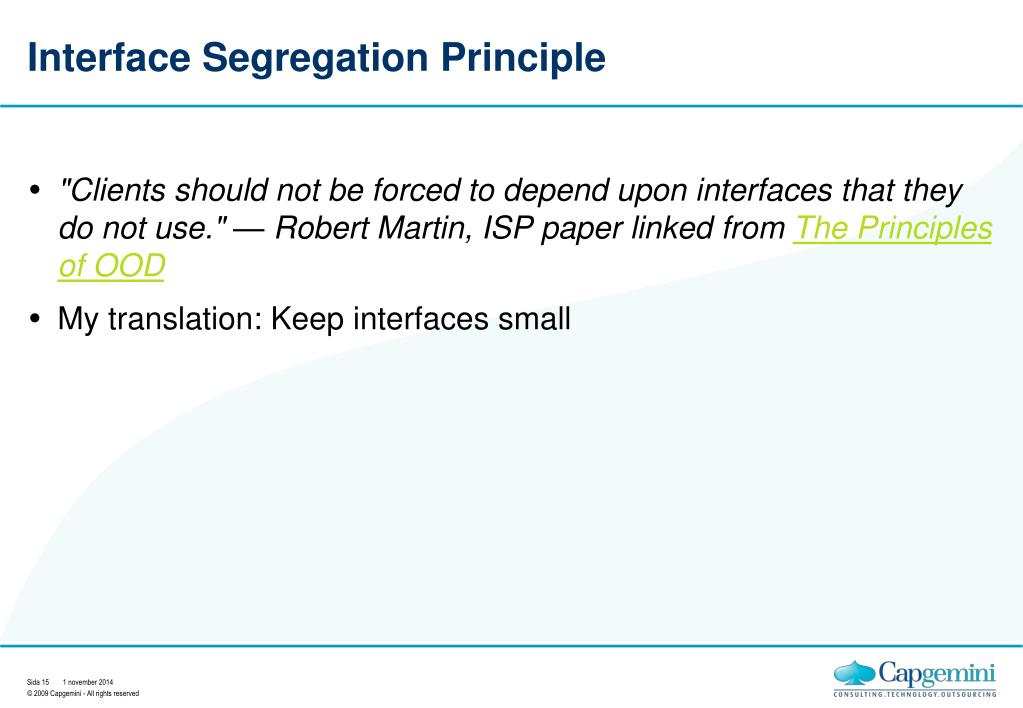
#Interface segregation principle software#
The complete Interface Segregation principle example is available on PlayGoKids repository. Interface Segregation Principle (ISP) In this tutorial, we will discuss Interface Segregation Principle (ISP) in SOLID Principles. Just like the rest of the five solid design patterns, the Interface Segregation Principle exists to help decouple modules within the software and make the code easier to understand, refactor, and maintain. This eventually helps us to follow the Single Responsibility Principle as well. Adhering to this principle helps to avoid bloated interfaces with multiple responsibilities. I invite you to have a look at the repository and run the examples: The Interface Segregation Principle is an important concept while designing and developing applications. The same example as SRP, but this time we represent it through the use of an interface, a fat one: public interface IOrderProcessor ISP splits interfaces that are very large into smaller and more specific ones so that clients will only have to know about the methods that are of interest to them. The common functions should be declared in all the overlapping interfaces. If the overlap is small, then the interfaces for the groups should remain separate. I use your classic tutorial for teaching ISP. In the field of software engineering, the interface segregation principle (ISP) states that no code should be forced to depend on methods it does not use. 9 From Agile Software Development, Principles, Patterns, and Practices: Pearson New International Edition: Sometimes, the methods invoked by different groups of clients will overlap. If you think about the (Single-Responsibility Principle (SRP)) 1, the same principles are applied here. The Interface Segregation Principle (ISP): Dont depend on things you dont need. The rule of thumb is " the more specific the better". When interfaces aggregate lots of generic behaviours they become difficult to maintain and evolve. Interfaces should be cohesive, clients should never be forced to implement an interface that they don't use, or clients shouldn't be forced to depend on methods they do not use. Make fine grained interfaces that are client specific.
#Interface segregation principle series#
This post is part of a series where we explore the SOLID design principles, arguably the most popular design principles for object-oriented software development. Package Interface Segregation Principle (ISP) is a principle that helps us to think about creating many specialized interfaces instead of a single general-purpose interface.

By implementing the Athlete interface we have to implement methods like highJump and longJump which JohnDoe will never use. Suppose that JohnDoe is a swimming athlete. Sometimes, the methods invoked by different groups of clients will overlap. These may be actual Interface typed entities or other classic objects implementing design patterns like Facades. In all modular applications there must be some kind of interface that the client can rely on.

We have added the method compete but also there some extra methods like swim highJump and longJump. From Agile Software Development, Principles, Patterns, and Practices: Pearson New International Edition. The Interface Segregation Principle (ISP) is about business logic to clients communication. In our case the Athlete interface is an interface with some actions of an athlete. Interface Segregation Principle avoids the design drawbacks associated with a fat interface by refactoring each fat interface into multiple segregated interfaces. Imagine an interface with many methods in our codebase and many of our classes implement this interface although only some of its methods are implemented.

The interface-segregation principle (ISP) states that no client should be forced to depend on methods it does not use. Next principle is the interface-segregation. Previously we examined the liskov substitution principle.


 0 kommentar(er)
0 kommentar(er)
